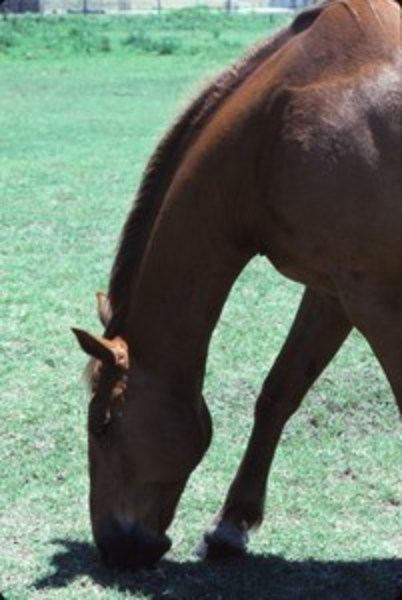Q&A: Why laminitis recurs
- March 10, 2017
- ⎯ Equus
Q: My 16-year-old warmblood gelding is recovering from a relatively mild case of laminitis. It was almost certainly caused by unusually rich pasture conditions, although he was used to being turned out nearly 24-7. I now confine him to a paddock with sparse grass. He had no rotation and is now sound. Can he ever be out on pasture again? Is there a safer time of day? I know spring and fall can be dangerous, when the grass is at its best. How about midsummer, or after the first killing frost? Having had laminitis once, is he more susceptible to getting it again? Is there anything else I should know about his ongoing care?

A: The number-one thing to remember if your horse gets laminitis is that the cause must be identified. Only by understanding why your horse developed this potentially crippling inflammation of sensitive laminae of the feet can you treat it effectively and prevent a recurrence.
Today we understand that laminitis can develop in three ways:
• The endocrine pathway is by far the most common form of laminitis. Also called “pasture-associated laminitis,” this form of the disease results from elevated levels of insulin0 in the blood. It tends to develop slowly, causing soreness in the feet but not necessarily severe pain. Separation and displacement of the coffin bone from the hoof wall is likely to be gradual, if it occurs at all.
• The inflammatory pathway is associated with fever and inflammation from infections commonly associated with diarrhea or any systemic disease. This form of laminitis tends to cause intense pain, and complete separation of the coffin bone from the hoof wall can develop within days.
• The supporting-limb pathway develops under mechanical stresses, such as when a horse injures one leg and bears more weight on the opposite limb.
When presented with a 16-year-old laminitic horse who has not had a fever or any signs of illness and who has been grazing pasture 24-7, I would call for some simple tests to see what is going on with his hormones. A fasting (no food for four hours) blood sample should be taken to check the horse’s blood insulin level as well as his level of the pituitary hormone ACTH (adrenocorticotrophic hormone). These two tests can determine if he has equine metabolic syndrome (EMS) or pituitary0 pars intermedia dysfunction (PPID), also known as Cushing’s disease. Both of these metabolic diseases can cause elevated insulin levels, which in turn can lead to laminitis.
In the United States, grass-induced laminitis is almost always associated with one of these two conditions, and if these tests had been run when this horse first developed laminitis, the question of whether the pasture was the cause would have been answered. I would suggest getting this horse tested even now because abnormal hormone levels can continue to cause low-grade laminitis, which may show no outward signs but can damage his feet.
If the tests come back as normal or only slightly abnormal, I’d recommend running an “oral sugar test.” In a fasting state, a blood sample is taken and then a dose of light Karo syrup (70 ml/1,000 pounds body weight) is given orally; then a second blood sample is taken in 90 minutes. In a normal horse the insulin level in the blood goes up from the dose of Karo syrup and drops again quickly, but in horses with EMS, the insulin remains high beyond the 90-minute time.
If your horse has abnormal hormone levels, medications, coupled with a dietary and exercise program, can bring him back to health. Once he’s back to a normal hormonal state, the question of grazing can again be considered. To be safe, most of these horses are kept off the spring and fall grass, but they can graze during the summer months.
Any bout of laminitis does permanent damage to the feet. The x-rays may appear fairly normal, but there are always irreversible changes to the attachments of the laminae. Any structure in the body that is altered from its original state is more prone to break down in the future. So, yes, any horse who has had laminitis in the past is at an increased risk of getting it again.
For long-term care, I’d suggest that horses who have been diagnosed with endocrine laminitis have their hormone levels rechecked every six months. This will ensure that the medications are keeping them at normal levels.
Today, many horses with hormone abnormalities lead normal lives with the assistance of medications, diet and exercise programs.
Donald Walsh, DVM Homestead Veterinary HospitalVilla Ridge, Missouri
This article first appeared in EQUUS issue #451, April 2015.





